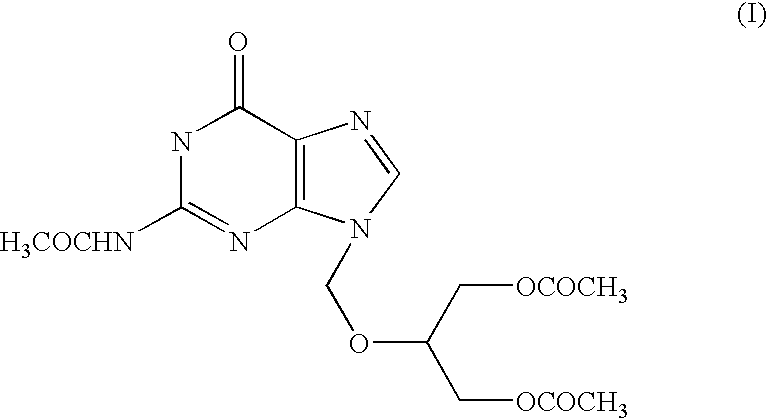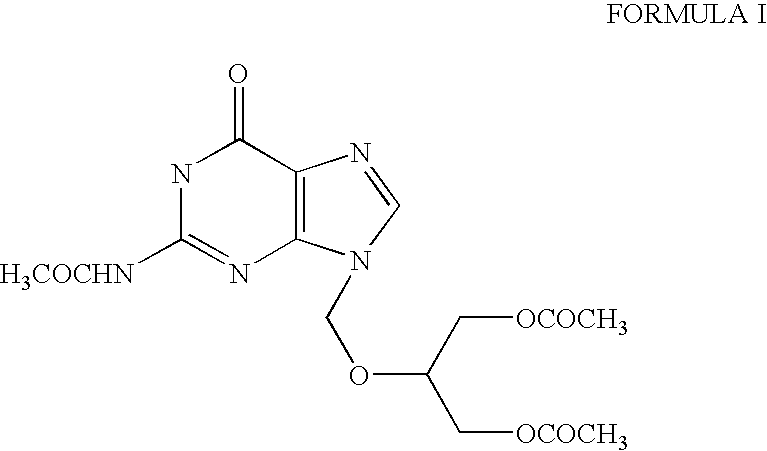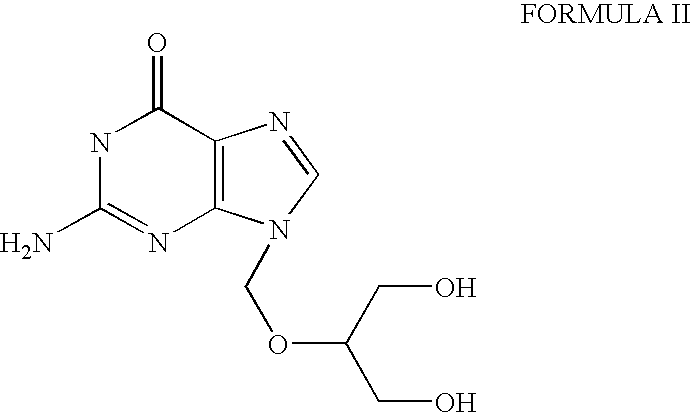Process for the preparation of ganciclovir
a technology of ganciclovir and process, which is applied in the field of process, can solve the problems of unsuitable approach and difficult commercial implementation of the approach
- Summary
- Abstract
- Description
- Claims
- Application Information
AI Technical Summary
Benefits of technology
Problems solved by technology
Method used
Image
Examples
example 1
[0031] Crude N2-Acetyl-9-(1,3-diacetoxy-2-propoxymethyl)guanine (100 kg) was added to the mixture of dichloromethane (500 lit) and methanol (40 lit). Temperature was raised to 30-35° C. and maintained for 30 minutes and then activated carbon (5 kg) was added and stirred for another 30 minutes at the same temperature. Slowly cooled to 5° C. and maintained for 30 minutes. Filtered through celite bed, removed the solvent completely by distillation, added acetone (800 lit.) to the resulting mass. Cooled to 35° C., stirred for 60 minutes at 30-35° C. Filtered the solids and washed with acetone, yielding 80-82 kg of pure N2-Acetyl -9-(1,3-diacetoxy-2-propoxymethyl) guanine.
Data onBeforeAfterchromatographic purityPurificationPurificationN-9 isomer95.0898.90DAG / MAG2.770.1N-7 isomer0.620.11
example 2
[0032] Crude N2-Acetyl -9-(1,3-diacetoxy-2-propoxymethyl) guanine (100 gm) was added to the mixture of dichloromethane (500 ml) and methanol (40 ml). Temperature was raised to 30-35° C. and kept for 30 minutes, and then activated carbon (5 gm) was added and stirred for another 30 minutes at the same temperature. Slowly cooled to 8° C. and maintained for 30 minutes. Filtered through celite bed and washed the bed using dichloromethane. Solvent was completely distilled off under vacuum. Charged fresh dichloromethane (200 ml) and heated up to 40° C. followed by cooling to 2-5° C. Filtered the product and washed with dichloromethane. Collected the wet material and charged acetone (700 ml) to the wet mass and heated to reflux temperature. Cooled to 35° C. stirred 60 minutes at 30-35° C. Filtered the solids and washed with acetone, yielding 68-72 gm of pure N2-Acetyl -9-(1,3-diacetoxy-2-propoxymethyl) guanine after drying.
Data onBeforeAfterchromatographic purityPurificationPurificationN-...
example 3
[0033] Crude N2-Acetyl -9-(1,3-diacetoxy-2-propoxymethyl)guanine (100 gm) was added to the DM water (250 ml.) at room temperature. Temperature was raised to 70-75° C. and kept 30 minutes, all solids completely dissolved at the same temperature. Slowly cooled to room temperature followed by further cooling to 5-10° C. and maintained for 60 minutes. Filtered the product at 5° C., yielding 58 gm of pure N2-Acetyl-9-(1,3-diacetoxy-2-propoxymethyl)guanine after drying.
Data onBeforeAfterchromatographic purityPurificationPurificationN-9 isomer77.1586.73DAG / MAG3.011.65N-7 isomer13.646.64
PUM
 Login to View More
Login to View More Abstract
Description
Claims
Application Information
 Login to View More
Login to View More - R&D
- Intellectual Property
- Life Sciences
- Materials
- Tech Scout
- Unparalleled Data Quality
- Higher Quality Content
- 60% Fewer Hallucinations
Browse by: Latest US Patents, China's latest patents, Technical Efficacy Thesaurus, Application Domain, Technology Topic, Popular Technical Reports.
© 2025 PatSnap. All rights reserved.Legal|Privacy policy|Modern Slavery Act Transparency Statement|Sitemap|About US| Contact US: help@patsnap.com



